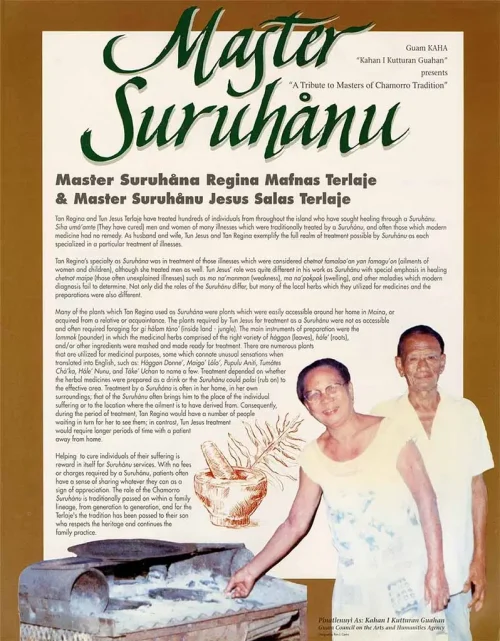Regina Mafnas and Jesus Salas Terlaje

Editor’s note: The following entry, with a few additions, was produced by the Guam Council on the Arts and Humanities Agency (CAHA) as part of their publication and poster series, A Journey with the Masters of Chamorro Tradition, 2000.
Master Suruhåna and Suruhånu
Tan Regina and Tun Jesus Terlaje have treated hundreds of individuals from throughout the island who have sought healing through a suruhånu. Siha umå’amte (They have cured) men and women of many illnesses which were traditionally treated by a suruhånu, and often those which modern medicine had no remedy. As husband and wife, Tun Jesus and Tan Regina each specialized in particular treatments of illnesses, and together they exemplified the full realm of treatment possible by suruhånu.
Tan Regina’s specialty as suruhåna was in treatment of illnesses which were considered chetnot famalao’an yan famagu’on (ailments of women and children), although she treated men as well. Tun Jesus’ role was quite different in his work as a suruhånu with special emphasis in healing chetnot maipe (those often unexplained illnesses) such as ma na’manman (weakness), ma na’pokpok (swelling), and other maladies which modern diagnosis fail to determine. Not only did the roles of the suruhånu differ, but many of the local herbs which they utilized for medicines and the preparations were also different.
Many of the plants which Tan Regina used as a suruhåna were plants which were easily accessible around her home in Ma’ina, or acquired from a relative or acquaintance. The plants required by Tun Jesus for treatment as a suruhånu were not as accessible and often required foraging gi hålom tano’ (inside land – jungle). The main instruments of preparation were the lommok (pounder) in which the medicinal herbs comprised of the right variety of håggon (leaves), håle’ (roots), and/or other ingredients were mashed and made ready for treatment. There are numerous plants that are utilized for medicinal purposes, some which connote unusual sensations when translated into English, such as: Håggon Donne’, Maigo’ Lålo’, Pupulu Aniti, Tumåtes Chå’ka, Håle’ Nunu, and Tåke’ Uchan to name a few. Treatment depended on whether the herbal medicines were prepared as a drink or if the suruhånu could palai (rub on) to the effective area. Treatment by a suruhåna is often in her home, in her own surroundings; that of the suruhånu often brings him to the place of the individual suffering or to the location where the ailment is to have derived from. Consequently, during the period of treatment, Tan Regina would have a number of people waiting in turn for her to see them; in contrast, Tun Jesus treatment would require longer periods of time with a patient away from home.
Helping to cure individuals of their suffering is reward in itself for suruhånu services. With no fees or charges required by a suruhånu, patients often have a sense of sharing whatever they can as a sign of appreciation. The role of the CHamoru/Chamorro suruhånu is traditionally passed on within a family lineage, from generation to generation, and for the Terlaje’s the tradition has been passed to their son who respects the heritage continues the family practice.
